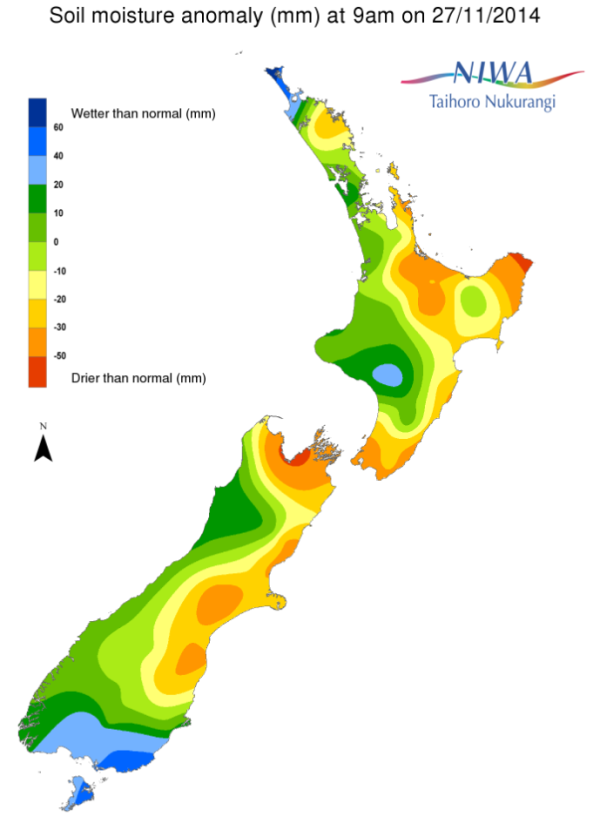Weekly update to help media assess likelihood of extremely dry weather preceding a drought. Regions experiencing severely to extremely drier than normal soils conditions are deemed “hotspots”.
Facts: Soil Moisture
For the North Island, soils continue to be much drier than normal (refer to figure below) for this time of year for much of the eastern and far southern sections of the island. More specifically, locations in the eastern Waikato to the Bay of Plenty, Gisborne, Hawke’s Bay to Wairarapa and Wellington regions. Locales in and around Tauranga to near East Cape are have severely to extremely dry soils for this time of year. The abnormally dry soils for this time of the year continues south along to the Hawke’s Bay region, Wairarapa, Wellington and southern Manawatu-Wanganui regions.
For the South Island, soil moisture levels are much drier than normal for this time of year for much of the northern and eastern parts of the island. This includes much of the Tasman, Nelson and Marlborough where severely to extremely dry soils for this time of year exist near, and especially west, of Nelson City over the north coastal Tasman region. Soil moistures remain drier than normal for this time of year for much of eastern Canterbury.
Week-to-Week Comparison
When compared to this time last week, there is some evidence of deteriorating conditions, in terms of coverage and dryness, over the eastern Waikato and Bay of Plenty regions with slight improvement over the Wairarapa region.
Noticeable improvement (moistening) of the soils have occurred over eastern Canterbury, in terms of coverage and intensity of soil moisture dryness. Abnormally wet soils for this time of year persist for much central and southern Southland as well as southern portions of Otago.
Commentary
When considering the current soil moisture anomalies for this time of year, hotspots are present in Tasman, Nelson and Marlborough regions – little or no change since last week. Hotspots also exist in much of eastern Canterbury and far northern Otago – slight to modest improvement since last week.
Immediately across the Cook Strait in the Wellington Region, South Wairarapa, Wellington City and the Kapiti Coast are additional hotspot areas – with slight improvement over South Waipara when compared to this time last week and little/no change for remaining aforementioned areas. For the rest of the North Island, hotspots include much of the eastern Waikato, Bay of Plenty and Gisborne regions as well as eastern Northland – with most of these regions experiencing a slight to modest worsening of soil moisture (drier conditions) when compared to last week.
For hotspot regions, sustained rainfall over several weeks is needed to return conditions back to normal. Additionally, if current conditions persisted, then drought conditions may be imminent.
Soil Moisture Anomaly Maps, relative to this time of year. Figure 1 shows this time last week. Figure 2 shows the most recent values.
Background:
Hotspot Watch a weekly advisory service for New Zealand media. It provides soil moisture and precipitation measurements around the country to help assess whether extremely dry conditions are imminent.
Soil moisture deficit: the amount of water needed to bring the soil moisture content back to field capacity, which is the maximum amount of water the soil can hold.
Soil moisture anomaly: the difference between the historical normal soil moisture deficit (or surplus) for a given time of year and actual soil moisture deficits.


